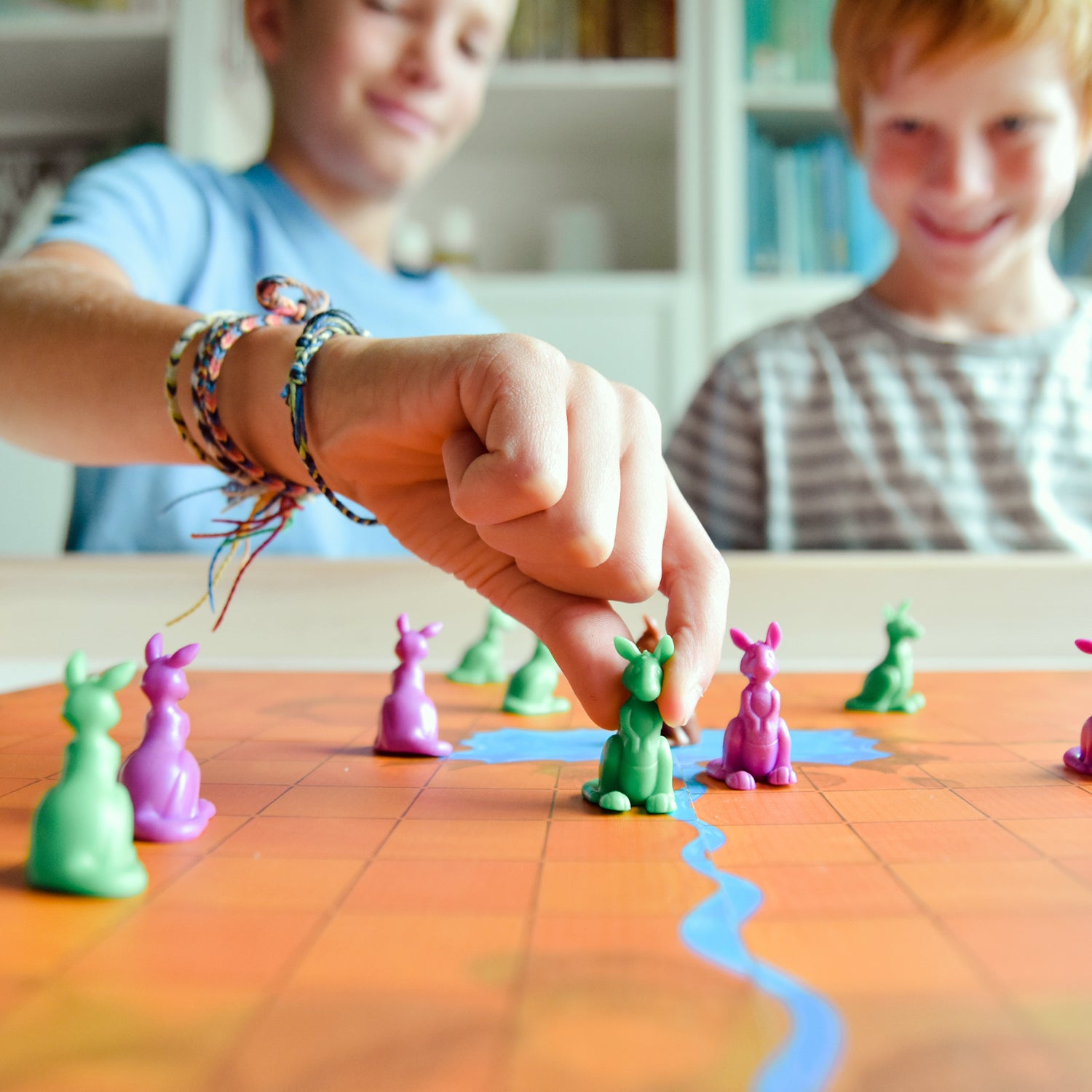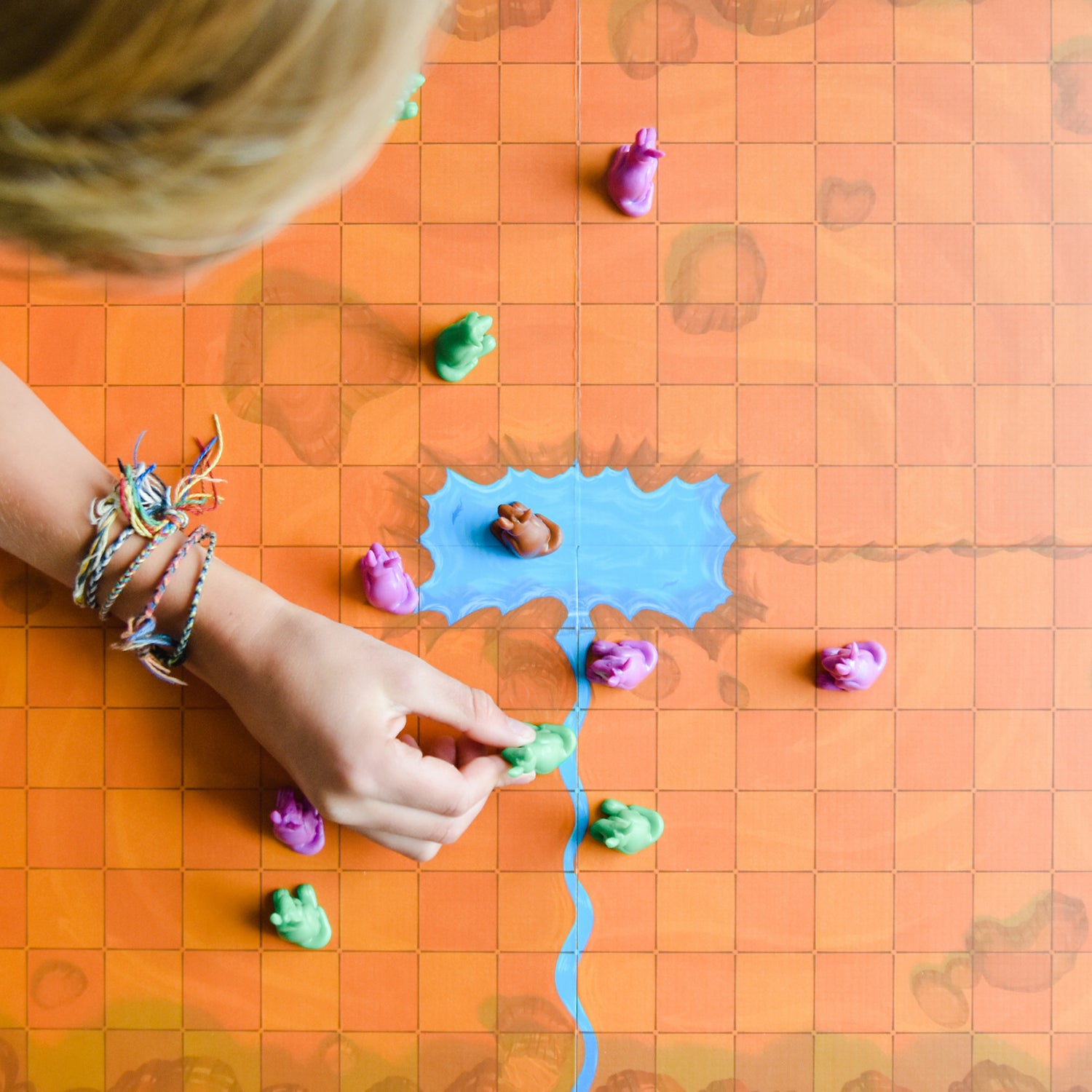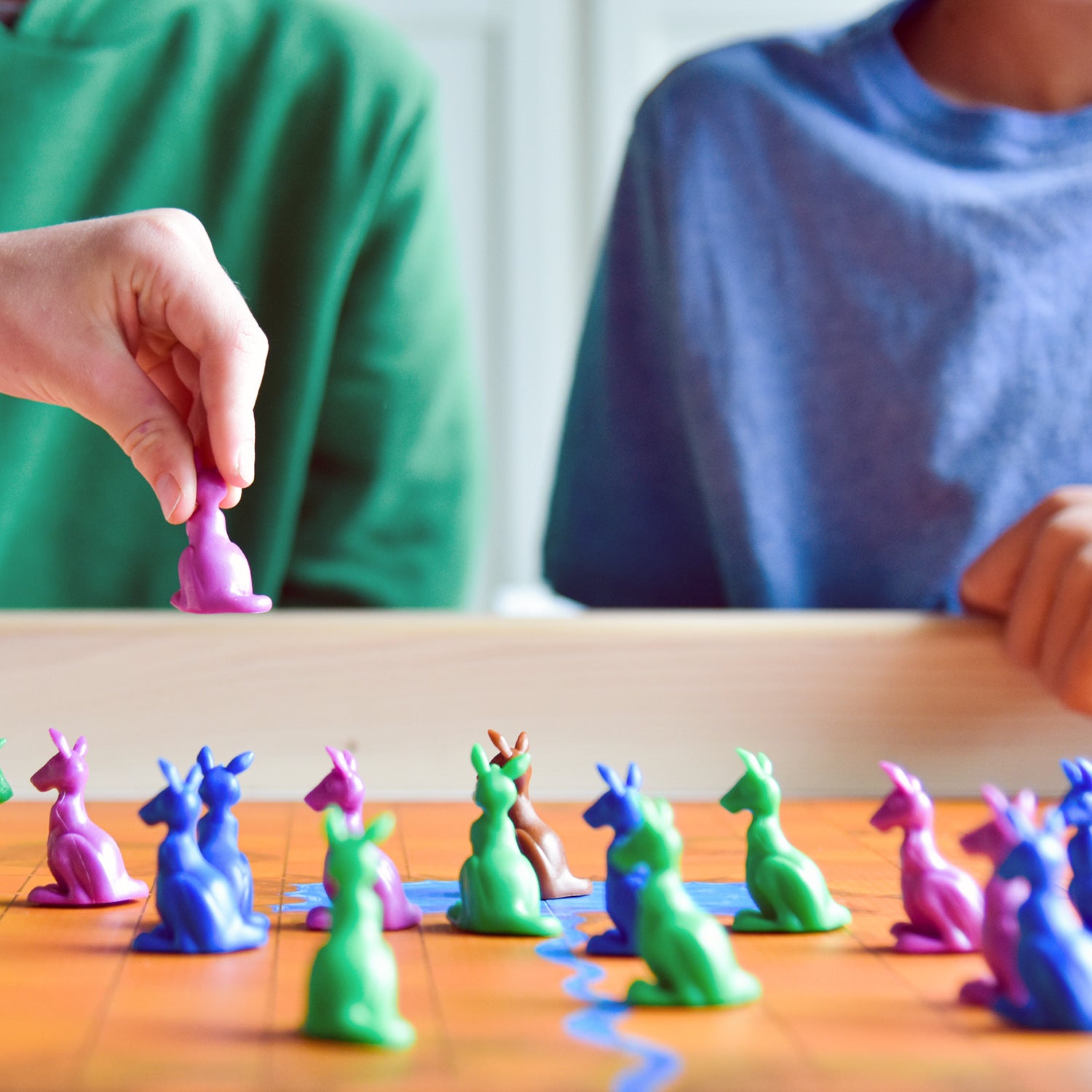High Tail It!
High Tail It!
2-4 players • 30 min • 10 & up
Focus: Strategy
Couldn't load pickup availability
Hop to victory with your kangaroos in this checkers style game! Use strategy, predict your opponents' moves, and plan your route to leap over them. Be the first to get all five kangaroos around the board and back across the river to win!
Skills: Strategy, Predicting, Planning
Game Includes
Game Includes
- 20 Plastic Kangaroo Pawns
- 1 Plastic Kangaroo Referee Pawn
- 1 Game Board
- 1 Cloth Storage Bag
- 1 Rules Booklet
Share

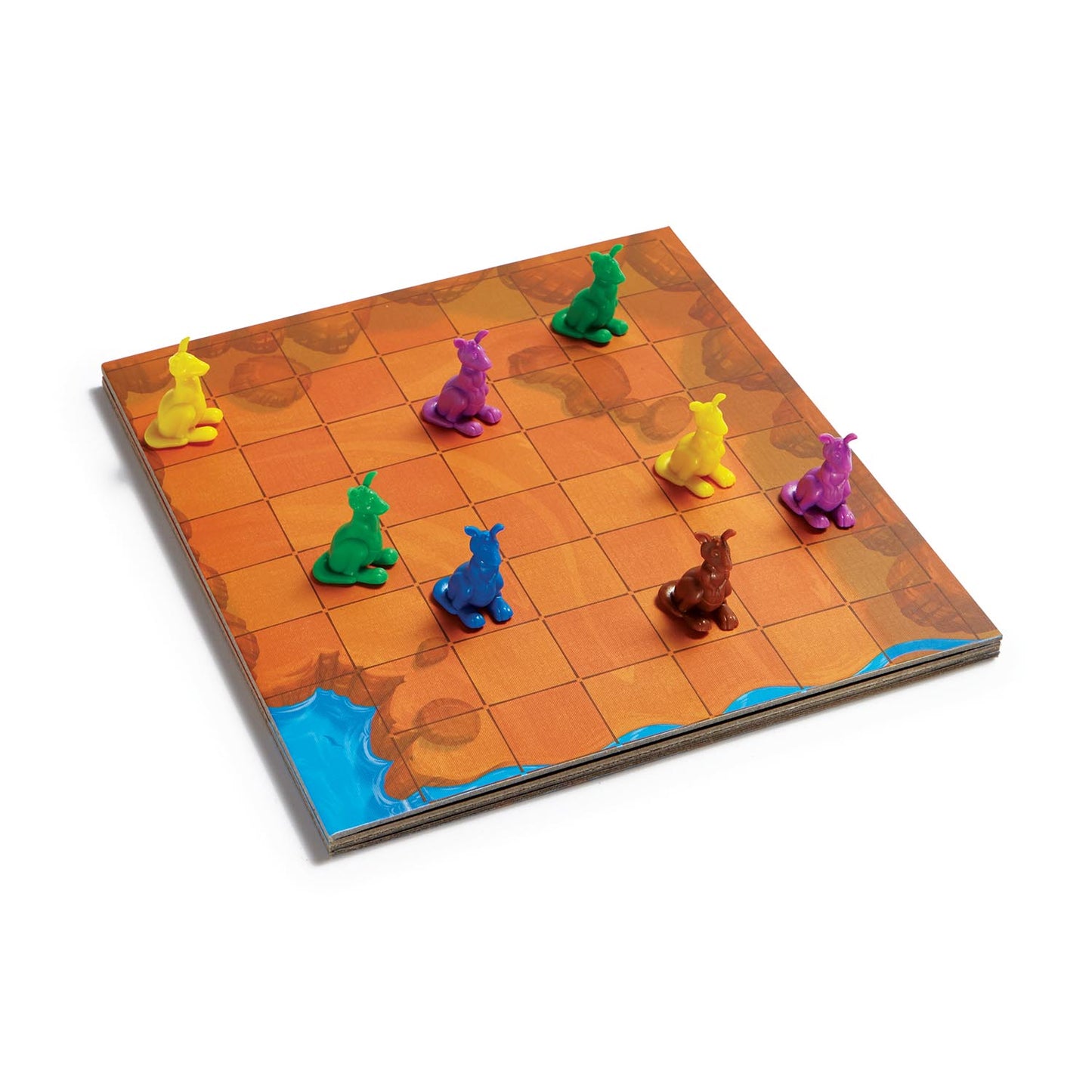
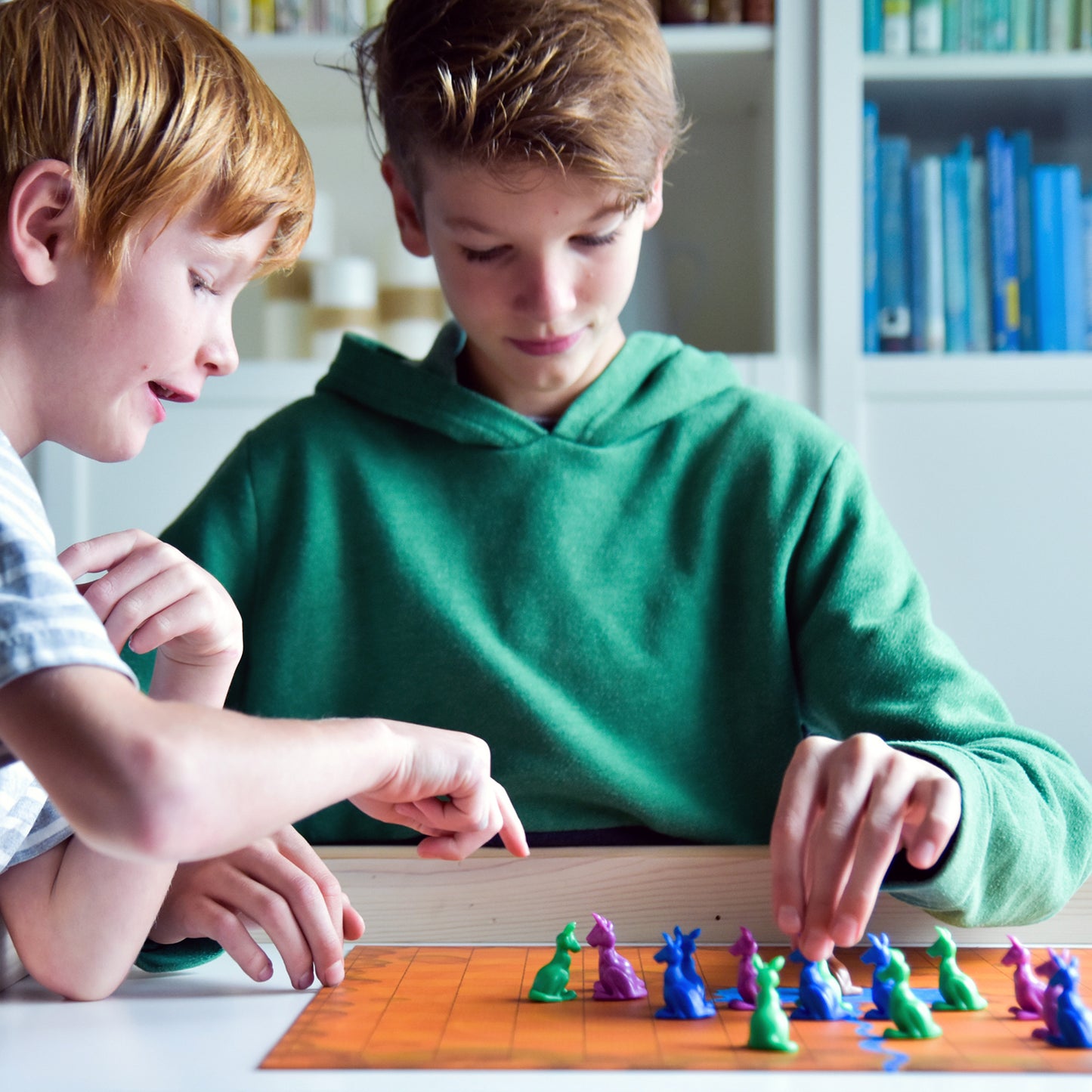
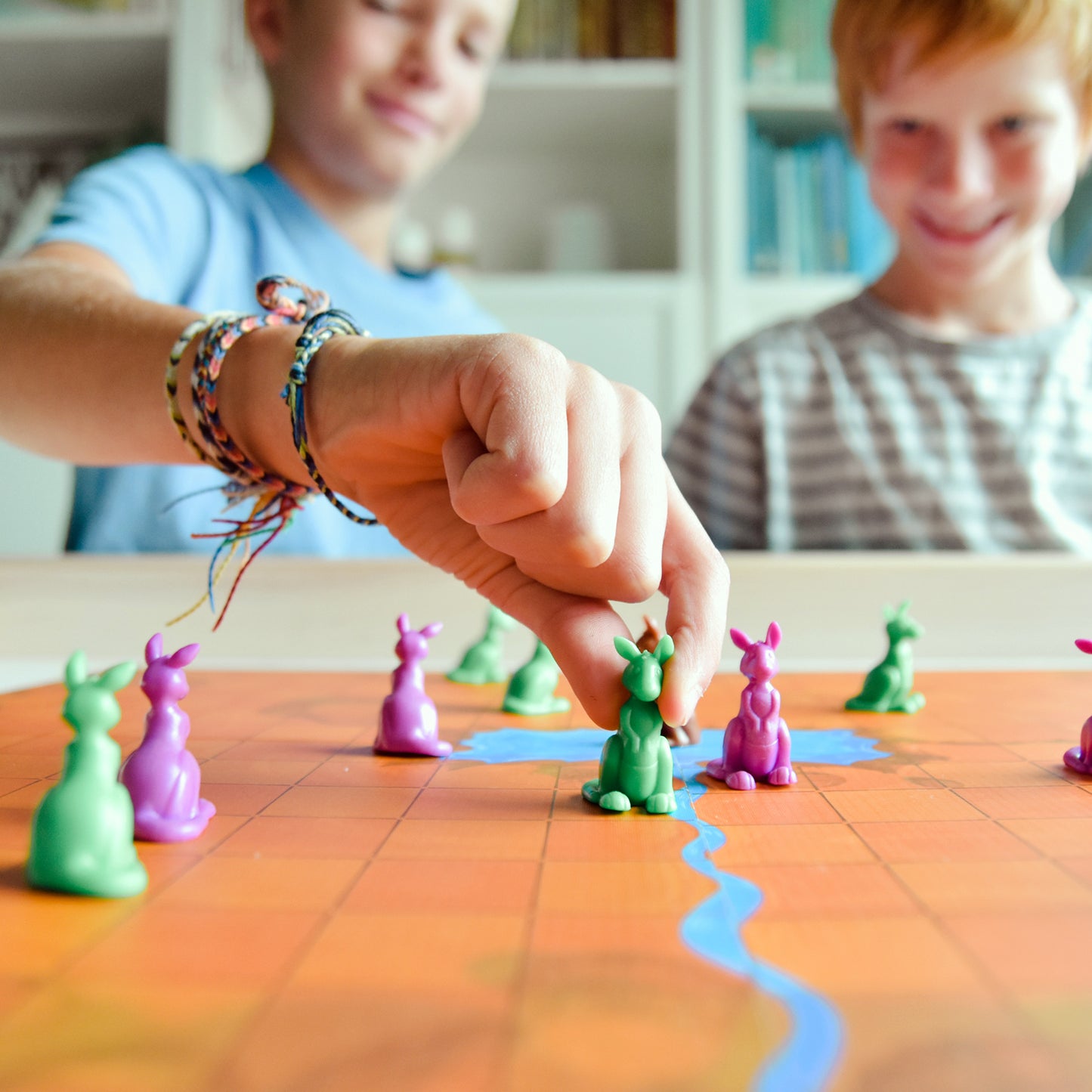
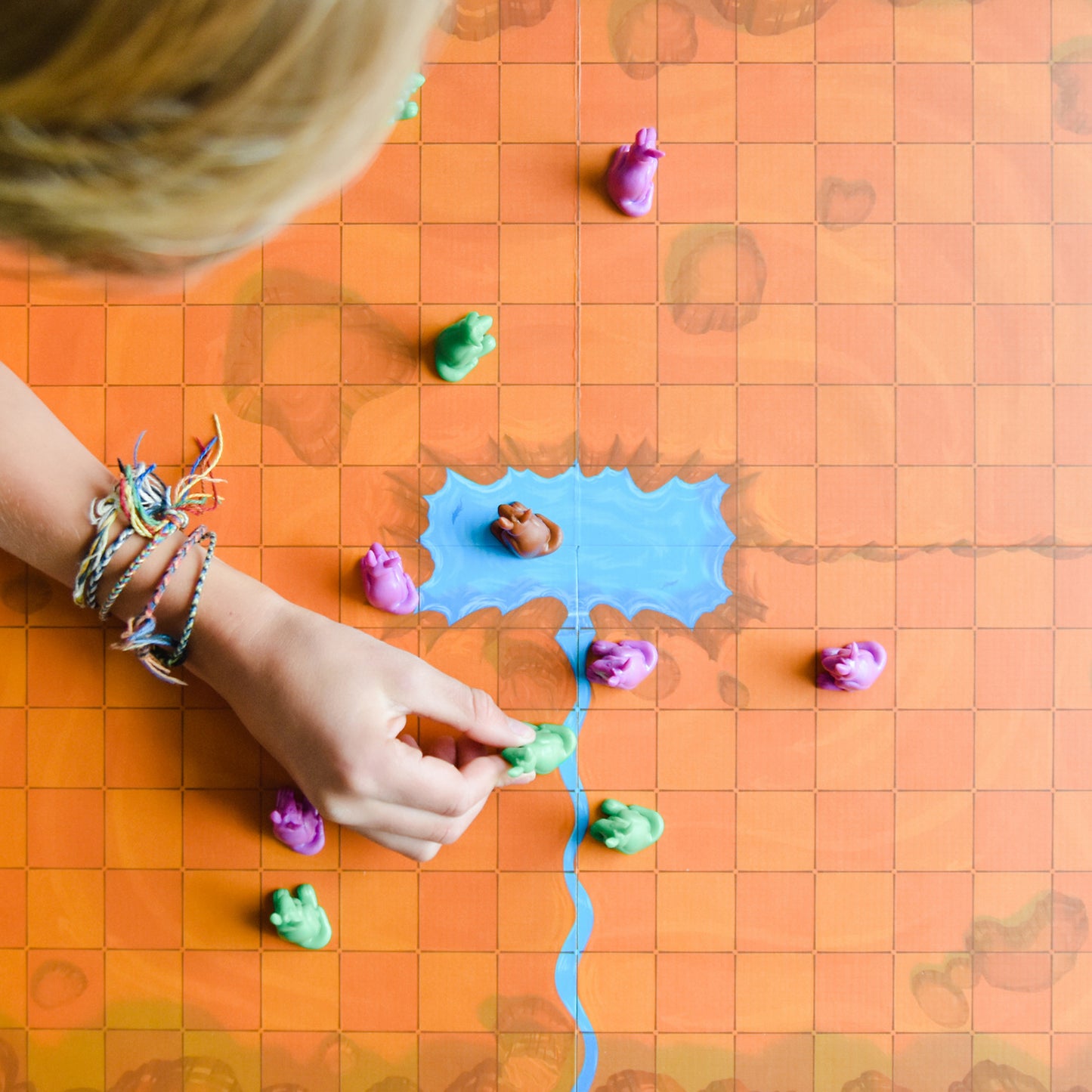
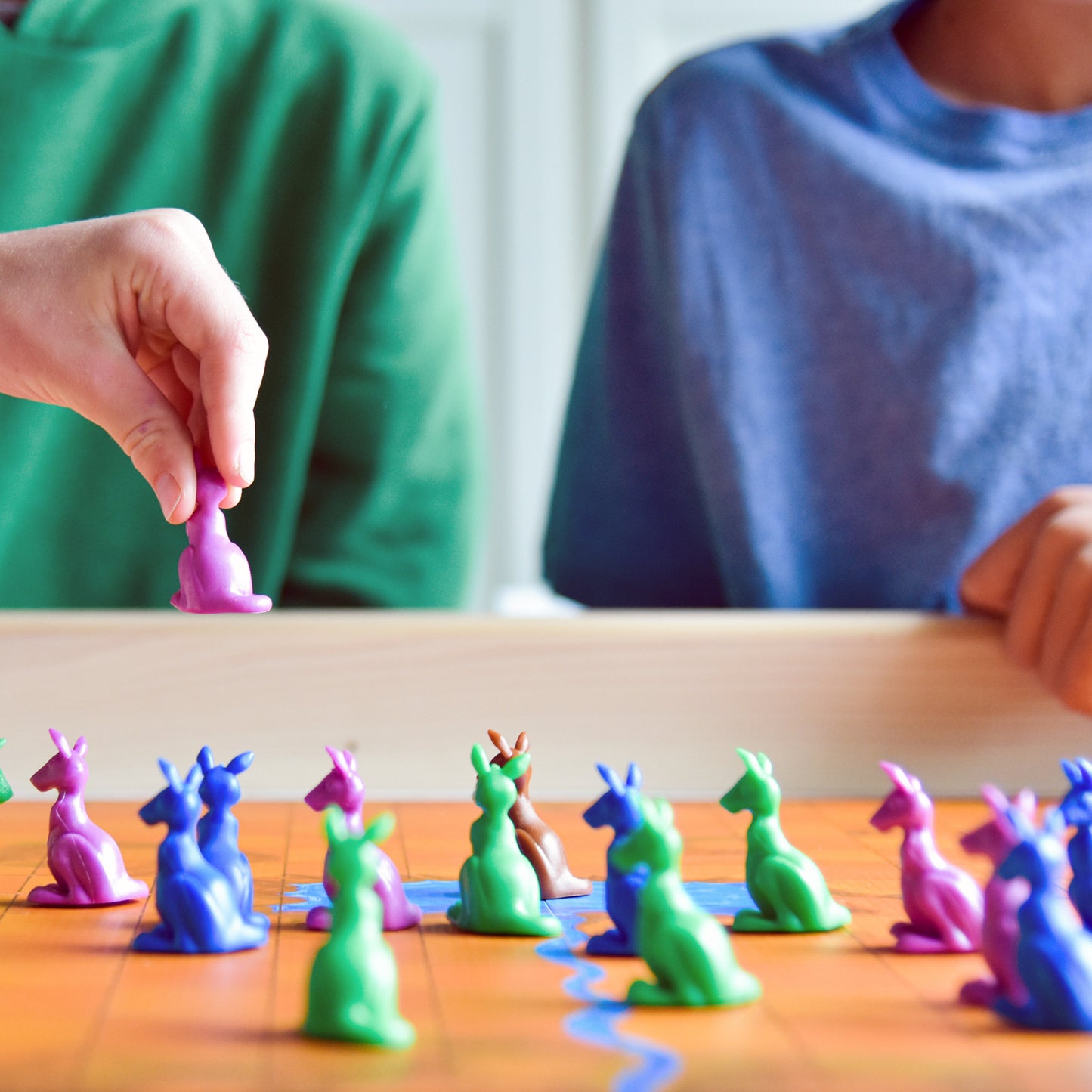

Collapsible content
How to Play
Educational Standards
Core Standard*: None
Skills
Explore
What Does Child Do To Use Skill In The Game?
Players explore the arrangement of Kangaroo pawns on the board during each turn.
How Parents Can Assist Learning
Parents can support children by encouraging them to look at all of the Kangaroo pawns, not just their own color.
Learning Implications and Educator Support
Playing High Tail It helps children develop spatial reasoning skills, planning, strategic thinking and perspective changing.Educators can support children by encouraging them to look at all of the Kangaroo pawns on the board, not just their own color. They can also explore the distances between the various kangaroos on the board.
Determine
What Does Child Do To Use Skill In The Game?
High Tail It requires a high level of determining as Players examine the board and arrangement of pieces in order to decide what possible moves they can make.
How Parents Can Assist Learning
High Tail It involves examining the board and creating mental models of the consequences of moving different Kangaroo pawns. When first learning to play, players will think about consequences of the immediate move. As they become more proficient, children will think about multiple moves ahead in order to evaluate what piece would be best to move on their turn.
Learning Implications and Educator Support
High Tail It involves examining the board and creating mental models of the consequences of moving different Kangaroo pawns. When first learning to play, players will think about consequences of the immediate move. As they become more proficient, children will think about multiple moves ahead in order to evaluate what piece would be best to move on their turn.
Compare
What Does Child Do To Use Skill In The Game?
Like determine, High Tail It requires a high level of comparing. Players will create mental models of the outcomes for moving different pieces. Based on those models, they will compare to determine the best move.
How Parents Can Assist Learning
To help children evaluate different options, encourage them to "Wait. Look. Think." This will help them spend time considering different moves and the consequences of those moves, which is needed for making comparisons of move options. This will also help with impulsivity and planning. Using such verbal cues can give children a model for approaching future play.
Learning Implications and Educator Support
Making mental models of a space and movement in High Tail It is an advanced, complex cognitive skill that supports learning spatial relations, pattern recognition and creative problem solving.
To help children evaluate different options, encourage them to "Wait. Look. Think." This will help them spend time considering different moves and the consequences of those moves, which is needed for making comparisons of move options. This will also help with impulsivity and planning. Using such verbal cues can give children a model for approaching future play.
Remember
What Does Child Do To Use Skill In The Game?
Players may remember moves from prior games that were successful or not.
How Parents Can Assist Learning
Parents can remind children of similar situations from prior games and what happened when a player moved a particular piece. Also, if you observe that some Kangaroo pawns are being left behind, remind the player that they want to move all of their Kangaroos forward as a group.
Learning Implications and Educator Support
Educators can remind children of similar situations from prior games and what happened when a player moved a particular piece. Also, if you observe that some Kangaroo pawns are being left behind, remind the player that they want to move all of their Kangaroos forward as a group.
Predict
What Does Child Do To Use Skill In The Game?
Players predict which Kangaroo their opponent may move on their next turn, and therefore, move one of their Kangaroo pawns to block their opponent.
How Parents Can Assist Learning
To help children predict, ask them to share different moves they are considering and what they think an opponent might move in response. Alternatively, ask them to think about what their opponent might move next. This requires playing non-competitively for the purpose of learning.
Learning Implications and Educator Support
Predicting involves skills like analysis, observation, empathy and interpretation. Also, children need to learn how to change perspective, imagining being their opponent, in order to have optimal predicting skills.
Educators can prompt children to practice predicting by asking them to share what opportunities they see on the board, different moves they are considering and what they think an opponent might move on their next turn. This requires playing non-competitively for the purpose of learning.
Plan
What Does Child Do To Use Skill In The Game?
Like prediction, planning is essential to the High Tail It as players think about future moves and how to make choices on their current turn that help advance their Kangaroos around the board.
How Parents Can Assist Learning
Encourage the children to discuss the goal for the game and how they might play their pieces to reach the goal. This requires playing non-competitively for the purpose of learning.
To help children plan their next move(s) encourage them to "Wait. Look. Think." This will help them spend time considering different moves and the consequences of those moves, which is needed for making comparisons of move options. This will also help with impulsivity and planning. Using such verbal cues can give children a model for approaching future play. Remind children to plan for each of their pieces, so none are left behind.
Learning Implications and Educator Support
Planning is an important skill for developing strategic thinking, persistence and reaching a goal.Encourage the children to discuss the goal for the game and how they might play their pieces to reach the goal. This requires playing non-competitively for the purpose of learning. Encourage strategic thinking for each of the player's kangaroos. Which should they move first to set up for the next play?
Experiment
What Does Child Do To Use Skill In The Game?
Players can try different approaches like making many small Jumps or try to set up fewer long Jumps.
How Parents Can Assist Learning
High Tail It is good for experimenting with strategy and tactics. Discuss different strategies prior to starting the game and encourage the child to select one. Play the game and discuss. Then, play again with the child trying a different strategy. Discuss again and compare the advantages and disadvantages.
Learning Implications and Educator Support
High Tail It is good for experimenting with strategy and tactics. Discuss different strategies prior to starting the game and encourage the child to select one. Play the game and discuss. Then, play again with the child trying a different strategy. Discuss again and compare the advantages and disadvantages.
Practice
What Does Child Do To Use Skill In The Game?
Players will increase proficiency the more they play High Tail It.
How Parents Can Assist Learning
High Tail has numerous implicit levels of mastery. Therefore, the more children play the more capable they will be in developing and executing increasingly sophisticated strategies. Also, as they become proficient, they will be able to teach others. Teaching others demonstrates mastery, the final stage of learning, and is wonderful for building self-esteem, confidence and intrinsic motivation.
Learning Implications and Educator Support
High Tail has numerous implicit levels of mastery. Therefore, the more children play the more capable they will be in developing and executing increasingly sophisticated strategies. Also, as they become proficient, they will be able to teach others. Teaching others demonstrates mastery, the final stage of learning, and is wonderful for building self-esteem, confidence and intrinsic motivation.
Solve
What Does Child Do To Use Skill In The Game?
Players solve the game by responding appropriately to opponents' moves and getting their Kangaroo pawns around the board first.
How Parents Can Assist Learning
High Tail It is good for trying different strategies to win. Discuss different strategies prior to starting the game and encourage the child to select one. Play the game and discuss. Then, play again with the child trying a different strategy. Discuss again and compare the advantages and disadvantages. Once children understand different strategies, they can shift and adapt strategies within a game.
Learning Implications and Educator Support
High Tail It is good for trying different strategies to win. Discuss different strategies prior to starting the game and encourage the child to select one. Play the game and discuss. Then, play again with the child trying a different strategy. Discuss again and compare the advantages and disadvantages. Once children understand different strategies, they can shift and adapt strategies within a game.
Review
What Does Child Do To Use Skill In The Game?
Players may review if encouraged. See Implications for Learning and Adult Support.
How Parents Can Assist Learning
During or after the game, discuss moves and what worked and did not work as expected.
Learning Implications and Educator Support
During or after the game, discuss moves and what worked and did not work as expected. Teachers can watch as children play and ask children to describe their thinking when they make a particularly good move.
Demonstrate
What Does Child Do To Use Skill In The Game?
Players may demonstrate if encouraged. See Implications for Learning and Adult Support.
How Parents Can Assist Learning
During or after the game, replay and discuss moves and what worked and did not work as expected. Thinking out loud is a good strategy for parents to use while playing the game. Children can be encouraged to do the same.
Learning Implications and Educator Support
During or after the game, replay and discuss moves and what worked and did not work as expected.
*Data compiled from CCSSI ELA Standards, WA Science Standards, and Washington Social Studies Standards
Special Needs
Cognitive
Suggestions for How to Modify Play Experience
Reduce the options for jumping. Play like checkers, so kangaroos can only move one or two spaces to jump forward, backward or diagonally. This will limit the number of options a child needs to remember or mentally visualize.
Reduce the directions the kangaroo can move. It can only move forward. This will reduce the number of options a child needs to remember or mentally visualize.
Have only three kangaroos each. This will make it easier to see the options available, and make the board less overwhelming.
Communication
Suggestions for How to Modify Play Experience
High Tail It does not require language, as players can move without talking. However, if a move is challenged by other players, the player who moved the piece will need to explain their reasoning.
Encourage children to explain their move. This will give them practice using language.
Sensorimotor
Suggestions for How to Modify Play Experience
High Tail It may be challenging for children who have difficulty manipulating small objects such as the kangaroos.
Social Emotional/Behavioral
Suggestions for How to Modify Play Experience
Some children may have a low frustration tolerance. For these children, ask them to explain what they are going to do before they make their move. This way adults or other players can explain any changes or alternatives that may be helpful.
Have all players explain their moves after they make them. This will help children learn new strategies to be more successful.
To encourage problem solving and reduce impulsive moves, have players identify two or three options for their kangaroos before making a move. Thinking of options is important for impulse control and creative problem solving.
Vision
Suggestions for How to Modify Play Experience
If fewer than four players are playing, use the kangaroos that are high contrast colors, such as yellow and green.
Use a black marker to draw over the grid lines on the board. This will define the spaces more clearly for children with low vision.
Children with very low vision may find It difficult to see all of the kangaroos and options clearly. Another player may be able to assist in pointing out the alternatives.
Hearing
Suggestions for How to Modify Play Experience
Use gestures to explain moves when needed. For example, hold up three fingers and indicate the move of three spaces ahead to jump a kangaroo and three spaces to jump diagonally.
*Data compiled from CCSSI ELA Standards, WA Science Standards, and Washington Social Studies Standards
Autism
Autism Strengths & Interests
Short Summary of Strengths & Interests
- Likes playing with small animal toys.
- Has good visual scanning ability to see patterns and opportunities to move pieces in a game.
- Likes games involving strategy.
Is good at matching visual items
This game is not appropriate
Has a good memory for sensory details, including visual, touch, taste and smell
This game is not appropriate
Has a good memory for words, phrases and dialouge
This game is not appropriate
Has a good memory for pictures, numbers and patterns
Is This Game Appropriate? Yes
Description
Like checkers or traditional chess, the more you play High Tail It the more easily you can see the options for jumping your kangaroos, as well as anticipating the moves of other players. Children need to establish and remember the pattern they select for their jumps. Children who are good at patterning games and spatial reasoning will be able to use and sharpen that ability playing High Tail It.
Likes to put things in order or a sequence
Is This Game Appropriate? Yes
Description
Children who are good at creating sequences will use that skill as they build sets of moves to jump their kangaroos around the board. They can use other players' kangaroos and position their own so that they can sequence their jumps to gain greater distances.
Learns through visualizing or "replaying" actions in their mind
Is This Game Appropriate? Yes
Description
Children with autism often have good visual spatial reasoning and are good at games like checkers and chess. These children can hone this ability playing High Tail It as they visualize the results of possible moves and think about options for their next turn based on the moves of other players.
Likes activities with rules, such as math and phonics
This game is not appropriate
Is very concrete and literal
This game is not appropriate
Learns in small "chunks" (for example, phone numbers are 3 chunks of number xxx-xxx-xxxx that are combined together)
This game is not appropriate
Is good at nonverbal reasoning and logic
Is This Game Appropriate? Yes
Description
Some children are good at logic and reasoning, but do not like to discuss or verbalize their thinking. In High Tail It, children analyze the locations of all of their own and other players' kangaroos to determine optional moves. They then select the move that gains them the most distance or the most strategic position. However, they do not need to discuss and talk about their reasoning and strategy.
Likes spatial problem solving
Is This Game Appropriate? Yes
Description
The essential rule of High Tail It is that a kangaroo can only jump an equal distance before and after a "pivot" kangaroo. A player can make several jumps in one turn and jumps over the next pivot kangaroo can involve a different number of spaces. So children who are good at thinking about space and the options for using the different kangaroos for gaining distance are at an advantage in the game.
Can read well with good vocabulary, though may not fully comprehend content
This game is not appropriate
Likes to use and has good fine motor skill
Is This Game Appropriate? Yes
Description
Children who like to play with small objects like blocks or action figures can use that skill in High Tail It. The spaces on the board and the kangaroos are small. There can also be many kangaroos on the board at one time, so good fine motor skills enable the child to maneuver successfully around and through the various arrangements of kangaroos.
Likes established routines or set ways of doing things
This game is not appropriate
Likes manipulating, constructing or building things
This game is not appropriate
Likes to use and has good musical abilities
This game is not appropriate
Likes to use and has good drawing skills
This game is not appropriate
Autism Special Considerations
Appears to ignore other's communication and/or has difficulty giving eye contact to a communication partner
Is This Game Appropriate for Child with Characteristic? Yes
Can Child with Characteristic Play Game w/o Modification? Yes
Strategies for Developing Compensatory Skills:
High Tail It does not require communication, but players must watch others' moves to see if they agree with kangaroo placement. Adults can ask children to check others' plays after a turn.
Has difficulty understanding complex verbal directions
Is This Game Appropriate for Child with Characteristic? Yes
Can Child with Characteristic Play Game w/o Modification? No
Strategies for Developing Compensatory Skills:
Directions for jumps my be difficult to understand. Children need to understand that equal spaces are needed on each side of a jump. Children will need multiple demonstrations. It may be easier for children with special needs to have simplified rules. For example, limit jumps to one or two spaces before and after the kangaroo to be jumped. Eliminate the possibility of shifting spatial distances during one turn of jumps.
Uses vocabulary inaccurately or demonstrates echolalia (repeating another's speech)
Is This Game Appropriate for Child with Characteristic? Yes
Can Child with Characteristic Play Game w/o Modification? Yes
Strategies for Developing Compensatory Skills:
High Tail It does not require talking. If children demonstrate echolalia, model a phrase that if repeated fits with the game. For example, "You jumped two kangaroos."
Gets stuck repeating a verbal topic or physical actions and/or has difficulty attending to others' actions or topic.
Is This Game Appropriate for Child with Characteristic? Yes
Can Child with Characteristic Play Game w/o Modification? Yes
Strategies for Developing Compensatory Skills:
This characteristic should not be problematic as long as it does not interfere with the child's own or other players' thinking. Redirect the child's language to comment on the characteristics on the board. For example, "Look how my kangaroos are spread out.." Direct the child's attention to each player's turn by pointing to the players dice instead of to the player. For example, "Watch what Amy does with her kangaroo." This allows the child to focus on the game without having to give eye contact.
Has difficulty producing speech/communication
Is This Game Appropriate for Child with Characteristic? Yes
Can Child with Characteristic Play Game w/o Modification? Yes
Strategies for Developing Compensatory Skills:
Communication is not necessary in High Tail It. Encourage children to communicate by giving them choices. "Should I jump this kangaroo or this one?" "Help me count the spaces before and after the kangaroos I jump."
Has difficulty sequencing multi-step actions and/or doing complex abstract tasks
Is This Game Appropriate for Child with Characteristic? Yes
Can Child with Characteristic Play Game w/o Modification? No
Strategies for Developing Compensatory Skills:
The directions for High Tail It are complex. Adults will need to demonstrate each part of the directions. Simplify the game if needed by allowing only one or two space jumps before and after a kangaroo; eliminate diagonal moves; or reduce the number of kangaroos used in the game.
Demonstrates difficulty initiating and maintaining social interactions
Is This Game Appropriate for Child with Characteristic? Yes
Can Child with Characteristic Play Game w/o Modification? Yes
Strategies for Developing Compensatory Skills:
Children may need to be reminded that it is their turn. Social interchange can be encouraged by having the child with special needs be the "turn announcer." The player points to and announces whose turn it is after each play. This encourages the child pay attention and participate.
Acts out or demonstrates avoidance behaviors when frustrated, overwhelmed, or needs more sensory input.
Is This Game Appropriate for Child with Characteristic? Yes
Can Child with Characteristic Play Game w/o Modification? No
Strategies for Developing Compensatory Skills:
Reduce extraneous noise.
A weighted vest worn during the game may provide additional pressure input and thus reduce fidgeting due to sensory needs. Pressure can be calming when used for no more than 20 minutes at a time.
Practice a phrase to ask for help and role play situations in the game where it is needed.
Provide techniques for self-calming, such as holding a fidget toy.
Allow time for movement. For example, a child who needs to move frequently can be given an opportunity to 'celebrate' their turn by running around the table or jumping up and down 10 times.
Has short attention span for non-preferred activities
Is This Game Appropriate for Child with Characteristic? Yes
Can Child with Characteristic Play Game w/o Modification? No
Strategies for Developing Compensatory Skills:
The game can be shortened by changing the way a player can win. For example, the first player to get two kangaroos across the river is the winner. The number of kangaroos each player uses can also be reduced.
Needs sameness or consistent routines and/or has difficulty with transitions from one activity to another
Is This Game Appropriate for Child with Characteristic? Yes
Can Child with Characteristic Play Game w/o Modification? No
Strategies for Developing Compensatory Skills:
Move strategies may change with each turn, which may feel uncomfortable to children with autism. Allow them to adopt a similar strategy each time, but point out their options, so they can begin to think of alternatives.
Play games at the same time every day, so the child anticipates the game routine.
Change the location of the game, so the child may play in different rooms, at the table, or on the floor. This will build tolerance for variation.
Prepare the child ahead of time for the introduction of a new game. Talk about aspects that will be motivating for the child, and let them explore the parts of the game before setting out the whole game.
Involve the child verbally and with actions for the transition to the game table or at the end of game play. For example, you might say, "Here are all the kangaroos, where do we put them back?"
Has difficulty understanding others' feelings, intentions, and the reasons for others' actions.
Is This Game Appropriate for Child with Characteristic? Yes
Can Child with Characteristic Play Game w/o Modification? No
Strategies for Developing Compensatory Skills:
The game can be played without competitive strategy by just having all players move all kangaroos over the river. Children with autism may have difficulty understanding another player's strategy. Have players explain what they are doing with each turn. This may help children with autism understand what other players are thinking.
*Data compiled from CCSSI ELA Standards, WA Science Standards, and Washington Social Studies Standards
Extended Play
Extra Ways to Play the Game
Have all kangaroos start from the same positions on the board rather than by choice of placement. This removes some of the initial strategy, but allows all to start with the same advantage.
Materials Needed
No additional materials needed.
Developmental Benefits
Children can observe other players moves from relatively similar positions and thus make a determination about matching or changing strategies.
Extra Ways to Play the Game
Play the game with different numbers of kangaroos and compare the challenges. Start by playing with three kangaroos, then try four, then five. Discuss the advantages and disadvantages of each
Materials Needed
No additional materials needed.
Developmental Benefits
Playing the game with different numbers of kangaroos will encourage children to make comparisons across the different approaches. Which took longer, had more move options, used the Referee more? Ask which of the variations were easier or harder to encourage evaluative thinking.
Extra Ways to Play the Game
Let children come up with additional rules for the Referee. For instance, you can only jump one square immediately in front of the referee; or you can pivot to the left or right, rather than go straight, when jumping over the Referee.
Materials Needed
No additional materials needed.
Developmental Benefits
Children love to make up their own rules. This gives them "ownership" of some aspect of the game. It also requires children to be flexible in their thinking, as the rules for the Referee can change each time the game is played.
*Data compiled from CCSSI ELA Standards, WA Science Standards, and Washington Social Studies Standards
Collapsible content
How to Play Video & Transcript
This racing game in the outback is for 2-4 players ages 8 and Up
High Tail It comes with 21 playing pieces and a playing board from down under. The playing pieces consist of 4 sets of colored kangaroos and the referoo kangaroo. You will also receive one cloth storage pouch to place all your roos.
High Tail It builds spatial reasoning and memory skills for young children as they move their pieces around the board, as well as promote the concept of teamwork as they position their roos to make the most of their jumps.
At the start of the game each player will in turn place one of their roos , , in the area between the river and the ridge until all the roos have been placed on the board.
Placing the roos at the beginning is just as important as how you gather them off at the end to give yourself lots of hopping opportunities.
As your roos attempt to make it around the water hole they may either walk one space in any direction or jump in any direction.
Your roos may not land in any space already occupied by another kangaroo, either by a walk or a jump.
The jumping roo may not jump over more than one kangaroo on any individual jump.
Yes that means you can jump more than one time per turn, but only with the same kangaroo.
A jumping kangaroo must not jump outside of the board space, so count carefully.
A jumping kangaroo must not jump over the pond, although skirting the edges on a diagonal jump is totally legal and even somewhat impressive.
The most important rule of jumping is that a kangaroo must- jump over another kangaroo. The kangaroo being jumped is referred to as the 'Pivot'. The pivot must be in a straight line from the jumping roo horizontally, vertically or diagonally on the current turn. You may jump over any individual kangaroo, yours, an opponents or the refaroo.
Here is the key to the game and your ability to bring your roos back across the river.
When a roo jumps over another roo they may only move the exact number of spaces that they are currently away from the kangaroo they are jumping.
So if you are two spaces away you may jump two spaces past the roo you are jumping. If you are right next to a roo you can jump directly over them to that adjacent space.
If you plan well you might even be able to create monster leaps of five or more.
You may continue to jump with your one kangaroo until there are no more roos to jump. You may even jump backwards to open up other opportunities.
Wow all that jumping can be confusing and you may lose track of where you went and where you started, don't worry we got your back covered.
This is where the refaroo comes into play. At the start of each players turn they will replace their starting space with the refaroo after they have taken their first jump. In addition to helping you remember your place in the game the refaroo may also become a pivot during your turn. Of course that is a very thirsty job and so at the end of each player’s turn the refaroo is returned to the pond where he can refresh and prepare himself for the next players turn.
Remember no walking and jumping on the same turn, it is a rarely known law in the outback but strictly enforced in the game.
So in order to finish the game a kangaroo must cross the river from the starting area, then circle the board clockwise, and finally finish by crossing the river once again.
After each roo finishes crossing the river, it is immediately removed from the game and cannot serve as a pivot anymore.
The winner must finish the course with all five roos crossing the river, so it is very important to not allow any kangaroos to lag behind.
Any kangaroos left behind have fewer pivots to utilize and will often need to walk a ways before being able to leap.
Using your roos to block others is an accepted strategy and necessary to restricting the progress of your opponents’ kangaroos.
So High Tail It to a fun evening of leaps, hops and plenty of laughter.
Subscribe for More Fun!
Be the first to know about new games, exclusive offers and more.
- YouTube
- TikTok
- X (Twitter)
- Choosing a selection results in a full page refresh.
- Opens in a new window.






